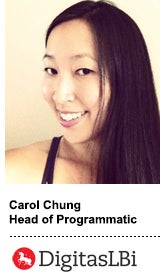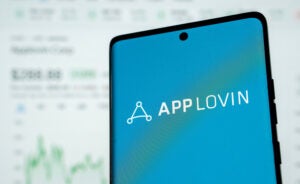 Ever since Publicis Groupe disaggregated its trading desk, VivaKi, programmatic has been searching for a new home within the holding company. DigitasLBi is taking an integrated approach by embedding programmatic experts into account teams.
Ever since Publicis Groupe disaggregated its trading desk, VivaKi, programmatic has been searching for a new home within the holding company. DigitasLBi is taking an integrated approach by embedding programmatic experts into account teams.
“I’m not looking to create a long-term programmatic team silo,” said Carol Chung, who became head of programmatic, North America, at DigitasLBi in September. “It’s really about incubating that expertise within all teams.”
In her new role, Chung will turn her 100-person media team into a group of programmatic experts. She’ll also advise and educate clients on the tools, pricing models and strategies that will leverage the most out of programmatic for their businesses.
“I’m not rolling out a one-stop, off-the-shelf service model or product to push on every account,” Chung said. “While it’s important to stay on top of [new technologies], it’s about keeping clients laser-focused on what’s going to advance their businesses.”
Many of Chung’s team members are ex-VivaKi executives, brought on to facilitate the education process with their specialized knowledge of trading.
“I want to get the right number of specialists in-house assigned to each account by region to act almost like an evangelist,” she said. “They can help get the agency there.”
Chung spoke with AdExchanger.
AdExchanger: How does decentralizing programmatic help break down silos across Publicis Groupe?
CAROL CHUNG: You hear people saying the future will be 100% programmatic. Whether or not that happens remains to be seen, but there is definitely the potential to shift more budget that way. What’s important for an advertiser is that you don’t continue to silo programmatic efforts. The ideal is having service and strategy integrated in one team. Programmatic isn’t this remnant tactic on the side [anymore]. Eventually it will extend into other channels. When clients talk about taking programmatic in-house, in some ways I embrace it. But if you’re thinking of taking talent in-house, it would ultimately create another silo.
Have you seen an uptick of clients taking programmatic in-house?
AdExchanger Daily
Get our editors’ roundup delivered to your inbox every weekday.
Daily Roundup
We’re at a point where people want to take something in-house. It’s the reaction to wanting more transparency and control. I’ve been to a lot of conferences where people are saying, “Take your contracts in house.” I think you can know what you’re paying without taking it in-house, but if you want to, that’s fine. It’s going to be more about data. The marketplace is recognizing that clients want more control over how we decision and buy inventory for them. Clients know they need to go there, but they don’t want to go there blindly.
Are you trying to be the partner that takes them there? Where does that leave you as an agency?
I don’t want to ever be in the position where a client feels like we’re recommending increasing spend in programmatic because that benefits us. I want to make sure we remain that objective third party and agent, not part of this larger industry that’s popped up around, “How can I make 10 cents off your dollar?”
How do you prove that to them?
The industry standard bases programmatic off of a percent of media cost. That’s something that I would like to change. If a client wants to pay me that way, that’s fine, but I want to be clear that if we increase your budget it might increase our share.
I’d rather disaggregate talent and tech from media performance cost because when it’s all bundled together it’s really hard to tell what’s working. Is it that the inventory was too expensive, or was it that the platform charged you a 20% fee? We have to work with our DSP partners to get a very clear breakout of the media and platform costs.
Some people are still charging flat-rate CPMs on a DSP, which is the antithesis of why you would be buying in this area. The market will sell you any myriad of ways to buy and you have to realize what’s best for the client.
Doesn’t it benefit vendors to keep fees bundled?
From a revenue and profit standpoint, it would obviously benefit them. But as we expand what we’re buying in programmatic, there’s a general rise in CPMs. We’re capturing premium-level inventory through private marketplaces, so the average CPM is going up.
Taking 10% of a $1 CPM is not a big deal, but taking 10% of a $20 CPM sounds like a lot. It was a model that worked when it was birthed, and now that we’ve evolved I want to push the evolution of the pricing models. It has to be driven by advertisers saying, “I’m buying differently and I need you to evolve with us.”
Sounds like an uphill battle.
A little bit.
How much education does that take on the client side?
A lot of education right now happens from the platform community because they’re the ones with the technology advancements. You can have Google come in and tell you what’s new on its road map and what its technology is now capable of. It’s applying that filter of remembering what its position is in all of this.
How much of your time is spent educating marketers on programmatic?
That’s a huge piece of my role. It’s like a consultancy role, looking at programmatic strategy enterprisewide. Everyone has figured out how to manage toward KPIs and their business goals on a campaign-by-campaign basis. Where I feel I’ve added the most value is by taking a step back and asking, “How can you centralize technology, data strategy or audience insights in a way that takes the whole enterprise another step forward?”
What do you think about management consultancies that are trying to do that for brands?
They are a daily reality of my life. What is going to be difficult for them is the activation piece. We can offer that type of consultancy, predicated on the fact that we are fully objective and there’s no reason for us to be proposing anything. We’re plugged directly into the activation and media teams, so whatever we work on, I can turn it on within a week or less.
What’s next in programmatic for the industry?
The further integration of artificial intelligence into programmatic. People always talk about the right message, right person, right time, but the holy grail is doing that at an enterprise level.
I think about it as a memory. I can identify a person every time I meet him or her and I know what creative I want to show. But what we haven’t yet cracked is, do I remember when I last saw that person, what I last said and how that person responded?
We have to expand upon what DSPs are currently capable of, what we’re feeding them to make them smarter and what we build for ourselves to augment that.













